1993 PONTIAC GRAND-AM oil change
[x] Cancel search: oil changePage 152 of 306
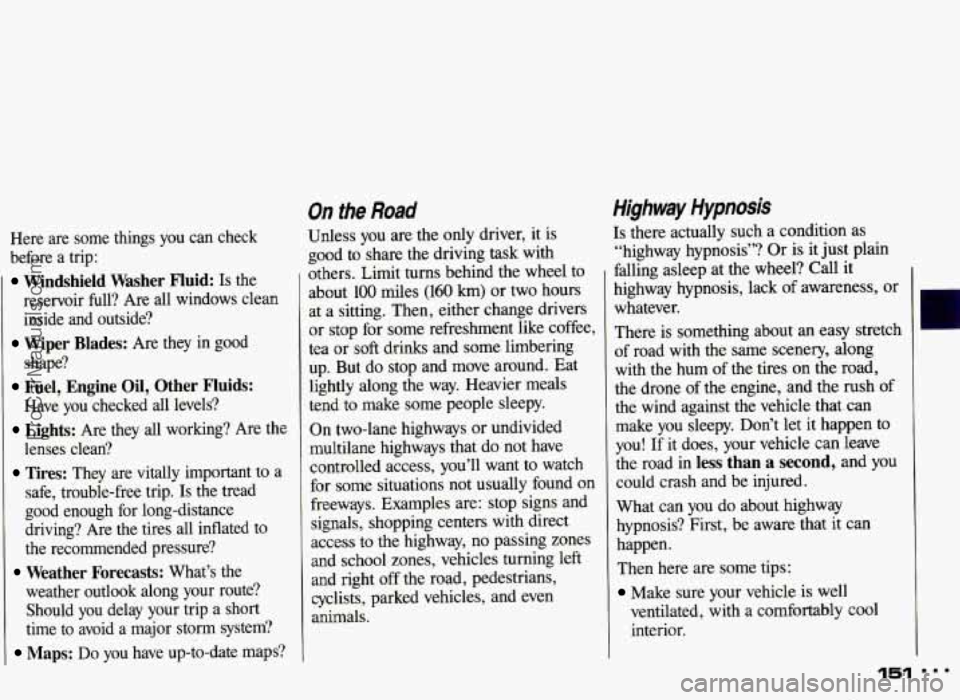
Here are some things you can check
before a trip:
Windshield Washer Fluid: Is the
reservoir full? Are all windows clean
inside and outside?
shape?
Have you checked all levels?
lenses clean?
safe, trouble-free trip.
Is the tread
good enough for long-distance
driving? Are the tires all inflated to
the recommended pressure?
weather outlook along your route? Should you delay your trip a short
time to avoid a major storm system?
Maps: Do you have up-to-date maps?
Wiper Blades: Are they in good
Fuel, Engine Oil, Other Fluids:
Lights: Are they all working? Are the
Tires: They are vitally important to a
Weather Forecasts: What’s the
On the Road
Unless you are the only driver, it is
good to share the driving task with
others. Limit
turns behind the wheel to
about
100 miles (160 km) or two hours
at a sitting. Then, either change drivers
or stop for some refreshment like coffee,
tea or
soft drinks and some. limbering
up. But do stop and move around. Eat
lightly along the way. Heavier meals
tend to make some people sleepy.
On two-lane highways or undivided
multilane highways that do not have
controlled access, you’ll want to watch
for some situations not usually found on
freeways. Examples are: stop signs and
signals, shopping centers with direct
access to the highway, no passing zones
and school zones, vehicles turning left
and right off the road, pedestrians,
cyclists, parked vehicles, and even
animals.
Highway Hypnosis
Is there actually such a condition as
“highway hypnosis”? Or is it just plain
falling asleep at the wheel?
Call it
highway hypnosis, lack of awareness, or
whatever.
There is something about an easy stretch
of road with the same scenery, along
with the hum of the tires on the road,
the drone of the engine, and the rush
of
the wind against the vehicle that can
make you sleepy. Don’t let it happen
to
you! If it does, your vehicle can leave
the road
in less than a second, and you
could crash and be injured.
What can you do about highway
hypnosis? First, be aware that it can
happen.
Then here are some tips:
Make sure your vehicle is well
ventilated, with a comfortably cool
interior.
151 ...
ProCarManuals.com
Page 191 of 306
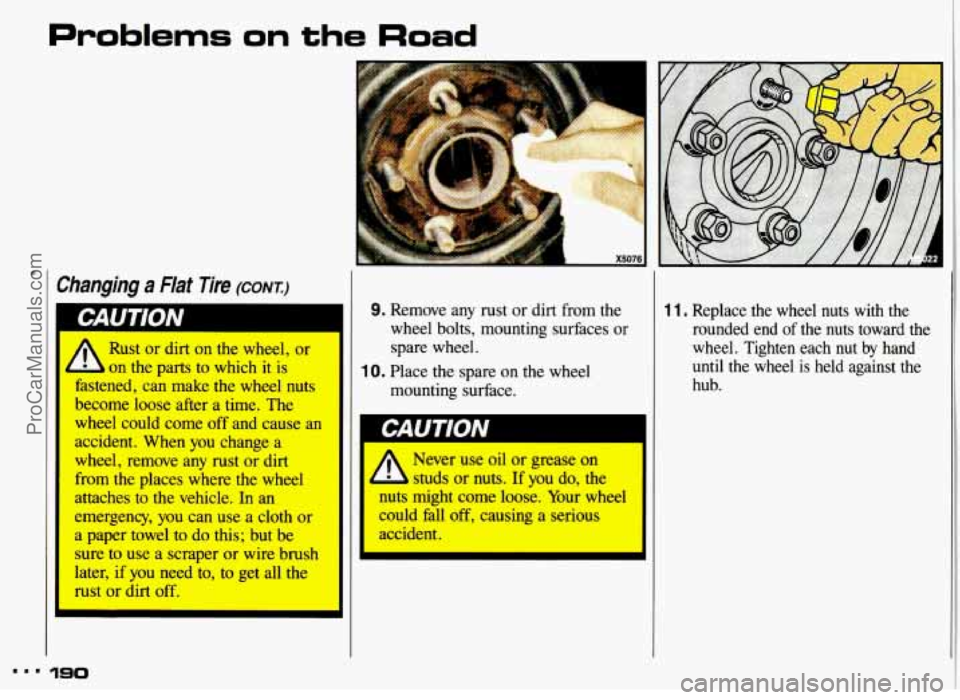
Problems on the Road
F"
'hanging a Flat Tire (CONT.)
f A Rust or dirt on the wheel, or
L on the parts to which it is
fastened, can make the wheel nuts
become loose after a time, The
wheel could come off and cause an
accident. When you change a
wheel, remove any rust or dirt
from the places where the wheel
attaches to the vehicle. In an
emergency, you can use a cloth or
a paper towel to do this; but be
sure to use a scraper or wire brush
later, if you need to, to get all the
rust or dirt off.
9. Remove any rust or dirt from the
wheel bolts, mounting surfaces or
spare wheel.
mounting surface.
10. Place the spare on the wheel
Never use oil or grease on
e b studs or nuts. If you do, the
nuts might come loose. Your wheel
could fall off, causing a serious
accident.
I
1 1. Replace the wheel nuts with the
rounded end of the nuts toward the
wheel. Tighten each
nut by hand
until the wheel is held against the
hub
..I 190
ProCarManuals.com
Page 213 of 306
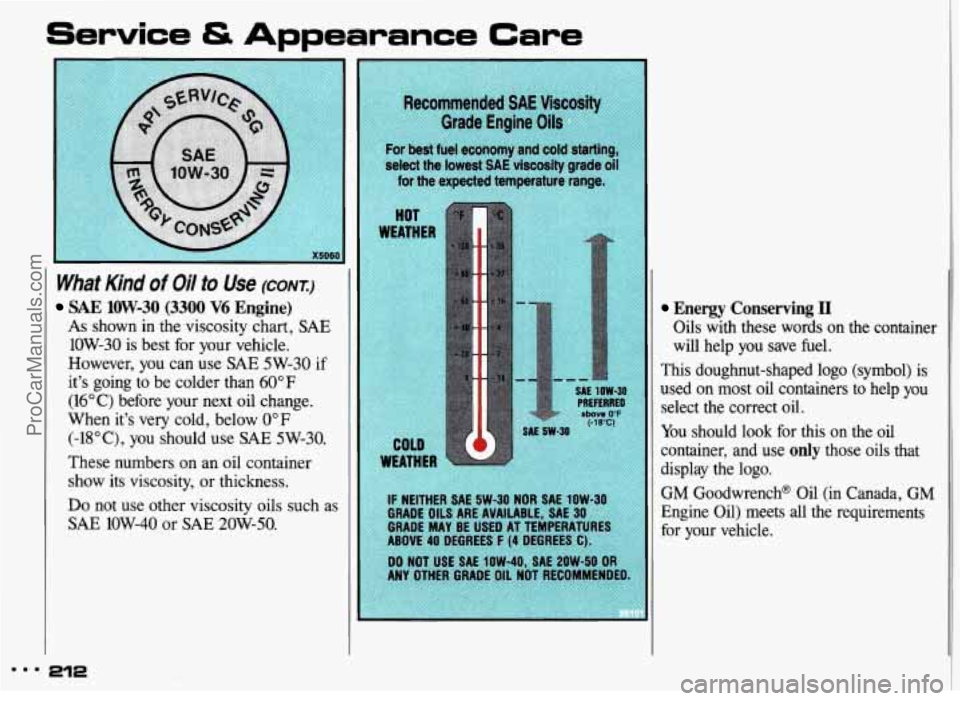
Service & Appearance Care
What Kind of Oil to Use (CONT.)
SAE low-30 (3300 V6 Engine)
As shown in the viscosity chart, SAE
1OW-30 is best for your vehicle.
However, you can use SAE
5W-30 if
it's going
to be colder than 60°F
(16°C) before your next oil change.
When it's very cold, below
0°F
(-18"C), you should use SAE 5W-30.
These numbers on an oil container
show its viscosity, or thickness.
Do not use other viscosity oils such as
SAE 1OW-40 or SAE 2OW-50.
212
Energy Conserving II
Oils with these words on the container
will help you save fuel.
This doughnut-shaped logo (symbol) is
used on most
oil containers to help you
select the correct oil.
You should look for this on the oil
container, and use only those oils that
display the logo.
GM Goodwrench@ Oil (in Canada, GM
Engine Oil) meets all the requirements
for your vehicle.
ProCarManuals.com
Page 214 of 306
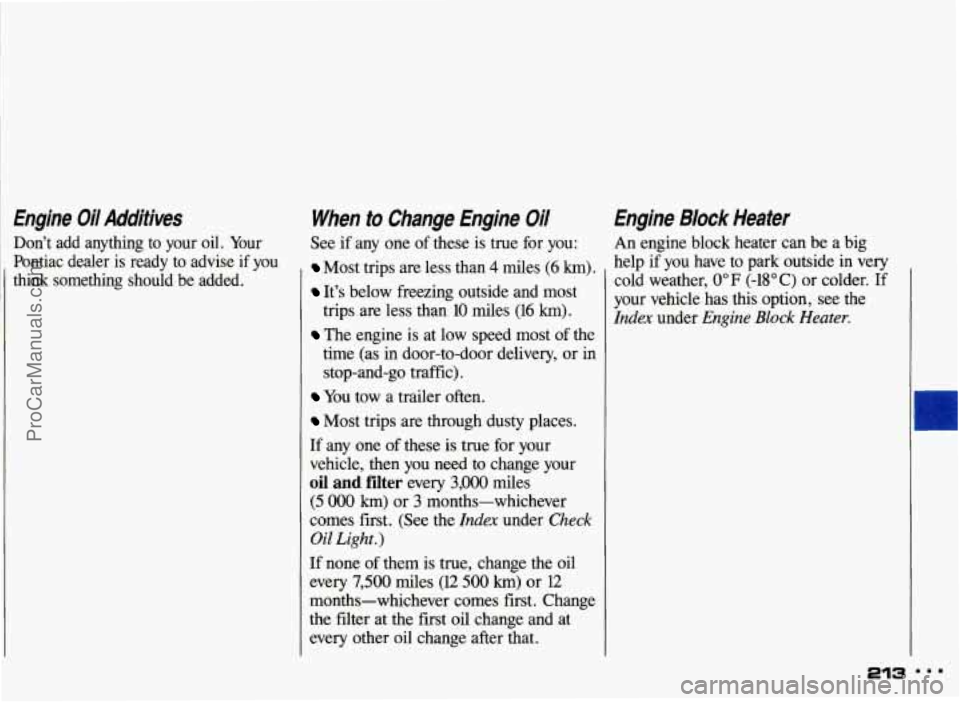
I
Engine Oil Additives
Don't add anything to your oil. Your
Pontiac dealer is ready to advise
if you
think something should be added.
When to Change Engine Oil
See if any one of these is true for you:
Most trips are less than 4 miles (6 km).
It's below freezing outside and most
trips are less than
10 miles (16 km).
The engine is at low speed most of the
time
(as in door-to-door delivery, or in
stop-and-go traffic).
You tow a trailer often.
Most trips are through dusty places.
If any one of these is true for your
vehicle, then you need to change your
oil and fdter every 3,000 miles
(5 0oO km) or 3 months-whichever
comes first. (See the
Index under Check
Oil Light.)
If none of them is true, change the oil
every
7,500 miles (12 500 km) or 12
months-whichever comes first. Change
the filter at the first oil change and at
every other
oil change after that.
Engine Block Heater
An engine block heater can be a big
help if you have to park outside
in very
cold weather,
0" F (-18°C) or colder. If
your vehicle has this option, see the
Index under Engine Block Heater.
213 I..
ProCarManuals.com
Page 215 of 306
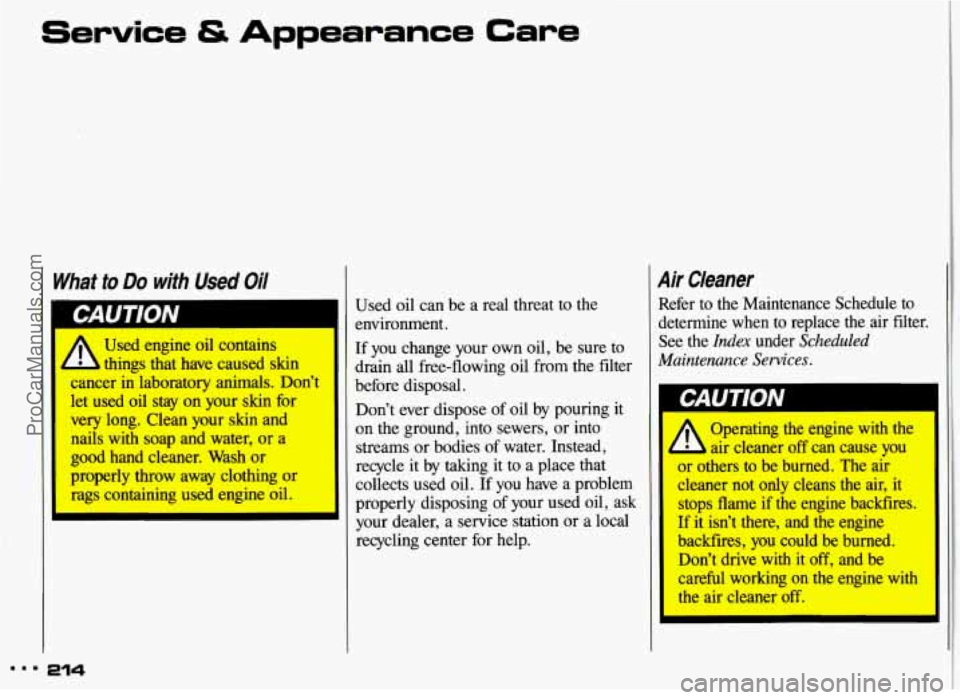
Service & Appearance Care
What to Do with Used Oil
A
Used engine oil contains
things that have caused skin
cancer in laboratory animals. Don’t
let used oil stay on your skin for
very long. Clean your
skin and
nails with soap
and water, or a
good hand cleaner. Wash or
properly throw away clothing or
rags containing used engine oil.
214
Used oil can be a real threat to the
environment.
If you change your own oil, be sure to
drain
all free-flowing oil from the filter
before disposal.
Don’t ever dispose of oil by pouring it
on the ground, into sewers, or into
streams or bodies of water. Instead,
recycle it by taking it to a place that
collects used
oil. If you have a problem
properly disposing
of your used oil, ask
your dealer, a service station or a local
recycling center for help.
Air Cleaner
Refer to the Maintenance Schedule to
determine when to replace the air filter.
See the
Index under Scheduled
Maintenance Sewices
.
CAUTION
A
Operating the engine with the
air cleaner off can cause you
or others to be burned. The air
cleaner not only cleans the air, it
stops flame if the engine backfires.
If it isn’t there,
and the engine
backfires, you could be burned.
Don’t drive with
it off, and be
careful working on the engine
with
the air cleaner off.
ProCarManuals.com
Page 217 of 306
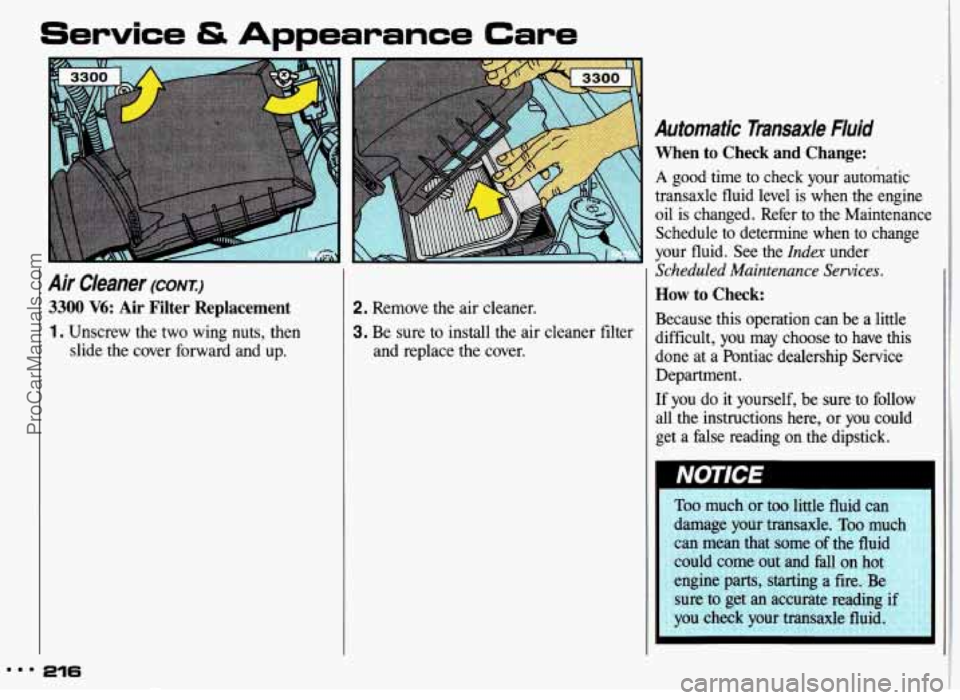
...
Service & Appearance Care
Air Cleaner (CONI)
3300 V6: Air Filter Replacement
1. Unscrew the two wing nuts, then
slide
the cover forward and up.
216
2. Remove the air cleaner.
3. Be sure to install the air cleaner filter
and replace the cover.
Automatic Tmnsax/e Fluid
When to Check and Change:
A good time to check your automatic
transaxle fluid level is when the engine
oil is changed. Refer
to the Maintenance
Schedule to determine when to change
your fluid. See the
Index under
Scheduled Maintenance Services.
How to Check:
Because this operation can be a little
difficult, you may choose to have this
done at a Pontiac dealership Service
Department.
If you do it yourself, be sure to follow
all the instructions here, or you could
get a false reading on the dipstick.
ProCarManuals.com
Page 219 of 306

Service & Appearance Care
Automatic Transaxle Fluid (CONT.)
How To Add Fluid:
Refer to the Maintenance Schedule to
determine what kind of transaxle fluid to
use. See the
Index under Fluids &
Lubricants.
If the fluid level is low, add only enough
of the proper fluid to bring the level into
the cross-hatched area on the dipstick.
It doesn’t take much fluid, generally less
than a pint. Don’t overfill. We
recommend you use only fluid
labeled DEXRON@-IIE, because fluids
with that label are made especially for
your automatic transaxle. Damage caused by fluid other than
DEXRON@-IIE is not covered by your
new vehicle warranty.
After adding fluid, recheck the fluid
level as described under
How tu Check.
When the correct fluid level is obtained,
push the dipstick back in all the way.
Manual Transaxle Fluid
When to Check:
A good time to have it checked is when
the engine oil is changed. However, the
fluid in your manual transaxle doesn’t
require changing.
How to Check:
Because this operation can be a little
difficult, you may choose to have this
done at a Pontiac dealership Service
Department.
If you do it yourself, be sure to follow
all the instructions here, or you could
get a false reading on the dipstick.
m.. 218
ProCarManuals.com
Page 227 of 306
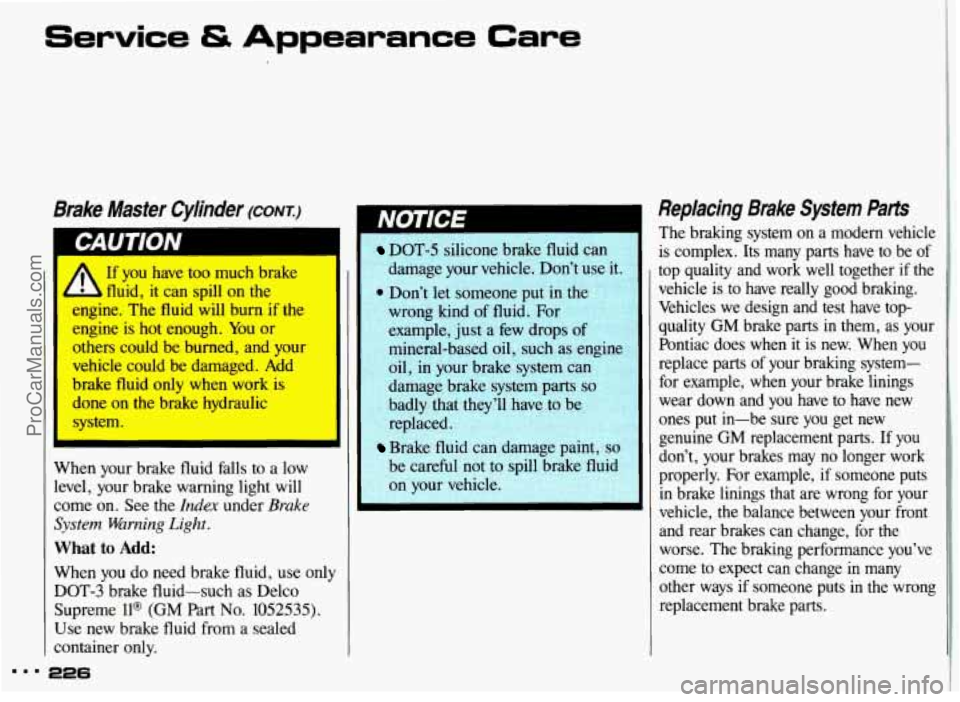
Service fS Appearance Care
Brake Master Cylinder (CONI)
I If you have too much brake
fluid, it can spill
on the
engine. The fluid will burn
if the
engine
is hot enough. You or
others could be burned, and your
vehicle could
be damaged. Add
brake fluid only when work is
done on the brake hydraulic
system.
When your brake fluid falls to a low
level, your brake warning light will
come on. See the
Index under Brake
System Warning Light.
What to Add:
When you do need brake fluid, use only
DOT-3 brake fluid-such as Delco
Supreme
ll@ (GM Part No. 1052535).
Use new brake fluid from a sealed
container only.
I DOT-5 silicone brake fluid can
;'Don't let someone put in the
:> 1 I :, !wrong i kind of fluid. For
example, just a few drops of
I , mineral-based oil, such as engine
-.?,'oil, in your brake system can
damage brake system parts
so
damage your vehicle. Don't use it.
". ,
I : '
" 1. , badly that they
; -qeplaced. %>, , .
Brake fluid can damage paint, so
be careful not to spill brake fluid
on your vehicle.
-
Replacing Brake System Parts
The braking system on a modern vehicle
is complex. Its many parts have to be of
top quality and work well together
if the
vehicle is to have really good braking.
Vehicles we design and test have top-
quality
GM brake parts in them, as your
Pontiac does when
it is new. When you
replace parts of your bralung system-
for example, when your brake linings
wear down and you have to have new
ones put in-be sure you get new
genuine
GM replacement parts. If you
don't, your brakes may no longer work
properly. For example,
if someone puts
in brake linings that are wrong for your
vehicle, the balance between your front
and rear brakes can change, for the
worse. The braking performance you've
come to expect can change
in many
other ways
if someone puts in the wrong
replacement brake parts.
m.. 226
ProCarManuals.com